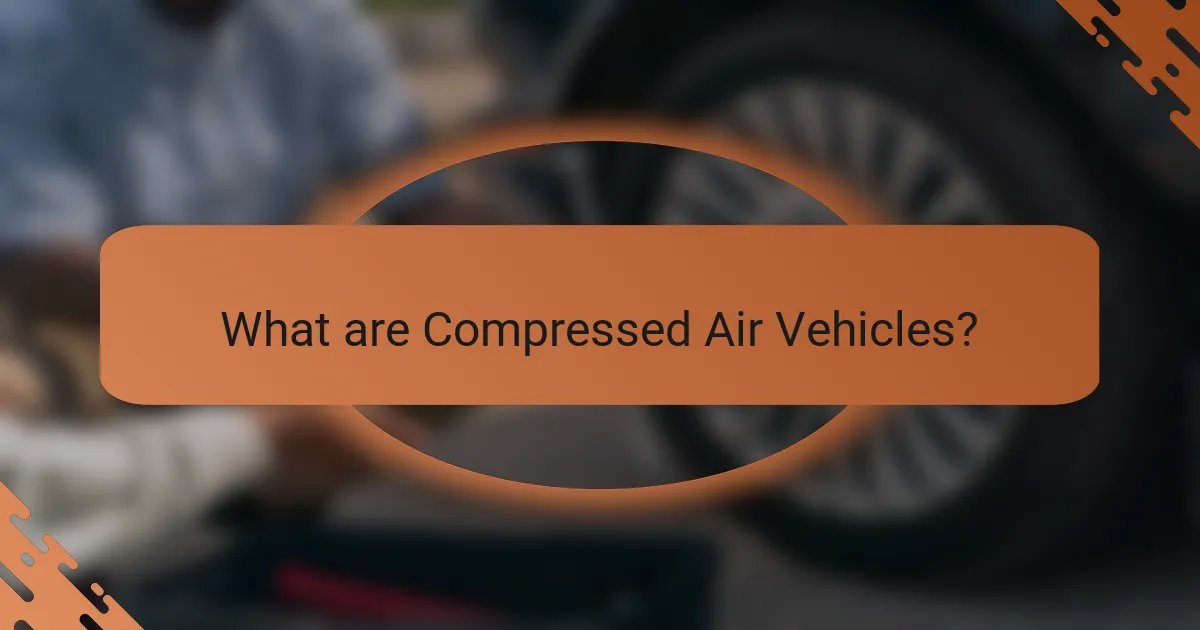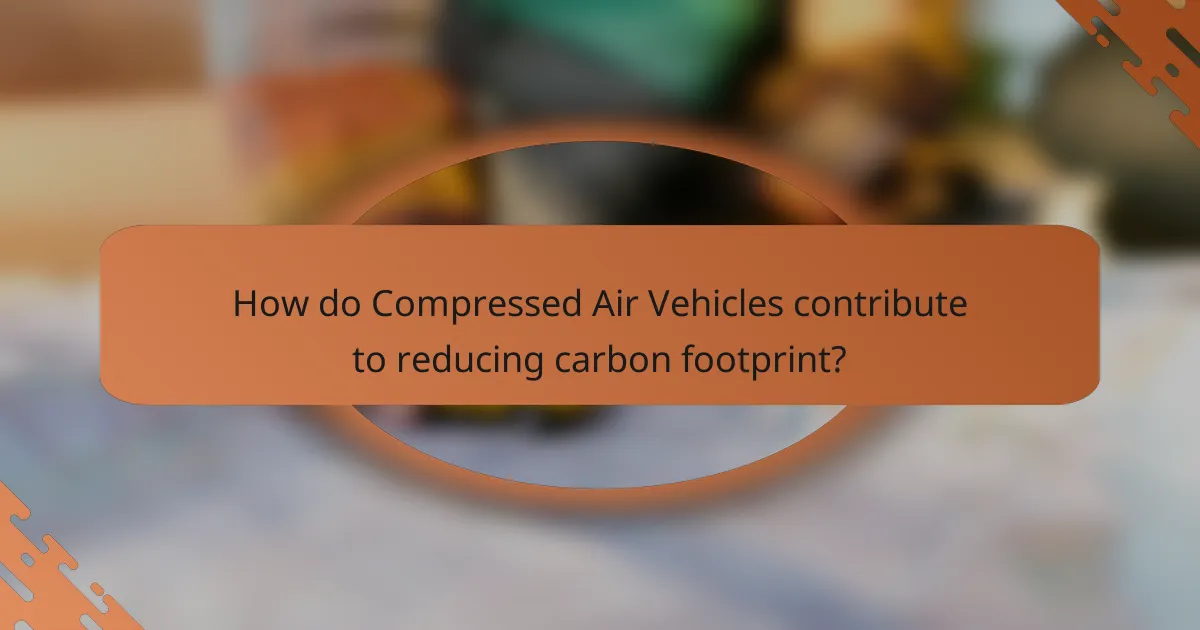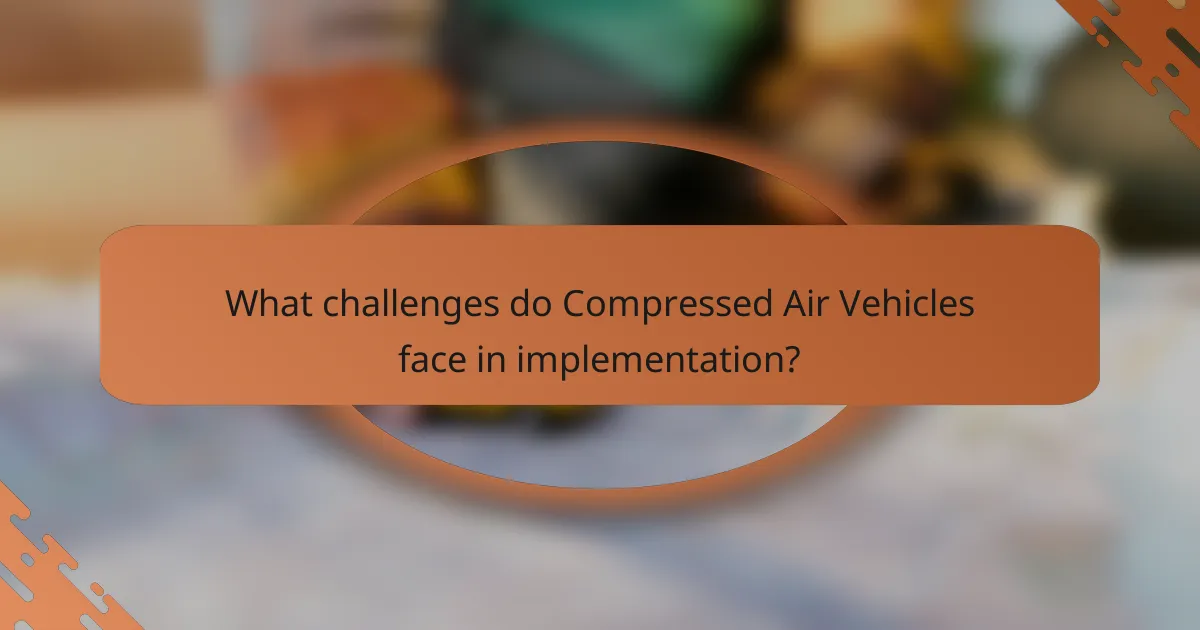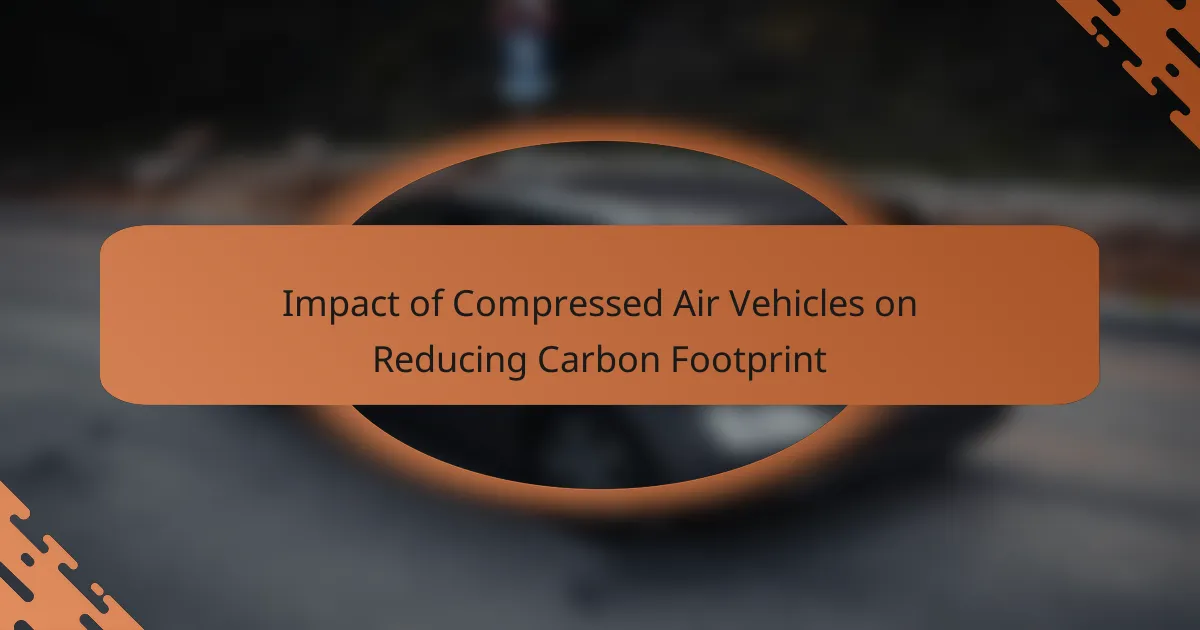Compressed Air Vehicles (CAVs) are vehicles that utilize compressed air as their primary energy source, enabling them to operate without traditional fossil fuels and produce zero tailpipe emissions. This technology significantly reduces greenhouse gas emissions and offers a cleaner alternative for urban transportation. While CAVs demonstrate potential for sustainable mobility, challenges such as limited energy density, high development costs, and underdeveloped refueling infrastructure hinder their widespread adoption. The article examines the impact of CAVs on carbon footprint reduction, highlighting both their benefits and the obstacles they face in the automotive market.

What are Compressed Air Vehicles?
Compressed air vehicles are vehicles powered by compressed air as their primary energy source. They utilize compressed air stored in tanks to drive pistons or turbines, converting air pressure into mechanical energy. This technology enables vehicles to operate without traditional fuels, reducing greenhouse gas emissions. Compressed air vehicles produce zero tailpipe emissions, contributing to cleaner air. They are considered an alternative to fossil fuel-powered vehicles. Research indicates that compressed air technology can significantly lower carbon footprints in urban transportation. The concept has been explored by various manufacturers and researchers, highlighting its potential for sustainable mobility solutions.
How do Compressed Air Vehicles operate?
Compressed Air Vehicles operate by using compressed air as a source of energy. The vehicle stores air in high-pressure tanks. When the vehicle is in motion, the compressed air is released. This air expands in a controlled manner to drive pistons or turbines. The movement of these components generates mechanical power. This power then propels the vehicle forward. Compressed air technology is efficient and produces zero emissions during operation. Studies show that using compressed air can significantly reduce reliance on fossil fuels, thus lowering the carbon footprint.
What are the main components of a Compressed Air Vehicle?
The main components of a Compressed Air Vehicle include a compressed air tank, an air motor, and a control system. The compressed air tank stores high-pressure air, which is essential for propulsion. The air motor converts the stored air into mechanical energy to drive the vehicle. The control system regulates air flow and manages the vehicle’s speed and performance. Additionally, some vehicles may include a chassis, wheels, and a braking system. These components work together to enable efficient operation and movement.
How is compressed air stored and utilized in these vehicles?
Compressed air in vehicles is stored in high-pressure tanks. These tanks are designed to withstand significant pressure, typically around 3000 to 4500 psi. The compressed air is utilized to power an engine that drives the vehicle. When the air is released, it expands and provides thrust. This process produces zero emissions, contributing to a reduced carbon footprint. The efficiency of compressed air systems can lead to lower operational costs compared to conventional fuel engines. Additionally, advancements in technology continue to enhance the storage and utilization capabilities of compressed air vehicles.
What are the advantages of using Compressed Air Vehicles?
Compressed Air Vehicles (CAVs) offer several advantages. They produce zero tailpipe emissions, significantly reducing air pollution. CAVs utilize compressed air as a clean energy source. This method decreases dependency on fossil fuels. CAVs are generally lighter than traditional vehicles, enhancing energy efficiency. They also have lower operational costs due to reduced energy expenses. Maintenance costs are lower because of fewer moving parts. Additionally, CAVs can be refueled quickly at specialized stations. These factors contribute to a more sustainable transportation option, aiding in the reduction of the carbon footprint.
How do Compressed Air Vehicles compare to traditional fuel vehicles?
Compressed Air Vehicles (CAVs) produce zero emissions compared to traditional fuel vehicles (TFVs), which emit greenhouse gases. CAVs utilize compressed air as a power source, while TFVs rely on fossil fuels. This fundamental difference significantly reduces the carbon footprint of CAVs. According to the International Energy Agency, transportation accounts for 24% of global CO2 emissions. CAVs can help mitigate this impact. Additionally, CAVs are often more energy-efficient, converting stored energy into kinetic energy without combustion losses. In contrast, TFVs have efficiency losses during fuel combustion. Therefore, CAVs present a cleaner alternative to TFVs, contributing to environmental sustainability.
What environmental benefits do Compressed Air Vehicles provide?
Compressed Air Vehicles (CAVs) provide significant environmental benefits by reducing greenhouse gas emissions. They operate using compressed air, which eliminates reliance on fossil fuels. This leads to lower carbon dioxide emissions compared to traditional vehicles. According to a study by the International Energy Agency, CAVs can reduce urban air pollution significantly. They contribute to improved air quality, which benefits public health. Additionally, CAVs produce less noise pollution, enhancing urban living conditions. Their efficiency in energy usage further contributes to a reduction in overall environmental impact.

How do Compressed Air Vehicles contribute to reducing carbon footprint?
Compressed Air Vehicles (CAVs) contribute to reducing carbon footprint by utilizing compressed air as a clean energy source. CAVs emit zero tailpipe emissions during operation. This significantly decreases greenhouse gas emissions compared to conventional gasoline or diesel vehicles. The use of compressed air reduces reliance on fossil fuels. Consequently, it lowers the overall carbon footprint associated with transportation. Studies show that CAVs can achieve efficiencies that rival electric vehicles. This makes them a viable alternative in the push for sustainable transport solutions.
What is the relationship between Compressed Air Vehicles and carbon emissions?
Compressed Air Vehicles (CAVs) produce zero carbon emissions during operation. This is because they utilize compressed air as a power source instead of fossil fuels. Consequently, CAVs contribute to reducing overall greenhouse gas emissions in urban transportation. A study by the International Energy Agency indicates that transitioning to alternative fuel vehicles can significantly lower carbon footprints. Therefore, the relationship between CAVs and carbon emissions is direct and positive, as they help mitigate climate change impacts.
How much carbon emissions can be reduced by adopting Compressed Air Vehicles?
Adopting Compressed Air Vehicles can reduce carbon emissions by approximately 60% compared to traditional gasoline vehicles. This significant reduction is due to the fact that compressed air vehicles do not emit carbon dioxide during operation. According to a study by the International Energy Agency, transitioning to compressed air technology can lead to substantial decreases in greenhouse gas emissions. The study highlights that if widely adopted, compressed air vehicles could contribute to a cleaner urban environment.
What factors influence the effectiveness of Compressed Air Vehicles in carbon reduction?
The effectiveness of Compressed Air Vehicles (CAVs) in carbon reduction is influenced by several factors. Key factors include energy source for air compression, vehicle design, and efficiency of air storage systems. If the energy used for compression comes from renewable sources, carbon reduction is maximized. Vehicle design impacts aerodynamics and weight, which affect energy consumption. Efficient air storage systems minimize energy loss during operation. Additionally, driving patterns and usage scenarios can influence overall emissions. Research shows that CAVs can significantly reduce emissions compared to traditional vehicles when these factors are optimized.
What role do Compressed Air Vehicles play in sustainable transportation?
Compressed Air Vehicles (CAVs) play a significant role in sustainable transportation by utilizing compressed air as a clean energy source. This technology reduces reliance on fossil fuels, thereby minimizing greenhouse gas emissions. CAVs operate by storing air in high-pressure tanks and using it to power the vehicle’s engine. Studies indicate that CAVs can achieve zero tailpipe emissions, contributing to improved air quality. Additionally, they can be refueled quickly and efficiently, similar to conventional vehicles. The integration of CAVs into public transport systems can further enhance sustainability by decreasing urban congestion and pollution levels. Overall, CAVs represent a promising alternative in the shift towards greener transportation solutions.
How can Compressed Air Vehicles integrate with existing public transportation systems?
Compressed Air Vehicles (CAVs) can integrate with existing public transportation systems through designated lanes and charging stations. These vehicles can utilize existing bus routes for efficient operation. CAVs can also be incorporated into multi-modal transport hubs. This allows seamless transfers between traditional buses, trains, and CAVs. Studies indicate that CAVs produce significantly lower emissions than conventional vehicles. Their adoption can lead to reduced urban air pollution. Cities like Paris have initiated pilot programs for CAV integration. These initiatives demonstrate the feasibility of CAVs in urban transport systems.
What are the long-term impacts of widespread adoption of Compressed Air Vehicles on carbon footprint?
Widespread adoption of Compressed Air Vehicles (CAVs) significantly reduces carbon footprints over the long term. CAVs operate using compressed air as fuel, producing zero tailpipe emissions. This leads to a substantial decrease in greenhouse gases compared to conventional vehicles. Studies indicate that transitioning to CAVs can lower urban air pollution levels. For instance, a shift to CAVs could reduce CO2 emissions by up to 50% in urban areas. Additionally, the lifecycle emissions of CAVs are lower due to less reliance on fossil fuels. As renewable energy sources become integrated into air compression technologies, the carbon footprint will decrease further. Overall, CAVs contribute to long-term sustainability and environmental health.

What challenges do Compressed Air Vehicles face in implementation?
Compressed Air Vehicles (CAVs) face several challenges in implementation. Limited energy density of compressed air reduces vehicle range compared to conventional fuels. High costs associated with developing efficient storage systems hinder widespread adoption. Additionally, infrastructure for refueling CAVs is underdeveloped, complicating user access. Performance issues in extreme temperatures affect reliability and efficiency. Environmental concerns regarding energy sources for compression can also arise. These factors collectively impede the practical deployment of CAVs in the automotive market.
What are the technical limitations of Compressed Air Vehicles?
Compressed Air Vehicles (CAVs) face several technical limitations. One major limitation is energy density. Compressed air has a lower energy density compared to conventional fuels. This results in reduced range and efficiency for CAVs. Another limitation is the storage system. High-pressure tanks are required, which can be heavy and bulky. This adds weight to the vehicle, impacting overall performance. Additionally, the refueling infrastructure for compressed air is underdeveloped. This restricts the convenience and accessibility for users. Finally, the efficiency of energy conversion in CAVs is relatively low. Current technology leads to significant energy losses during compression and expansion processes. These factors collectively hinder the practicality and adoption of Compressed Air Vehicles.
How do charging infrastructure and energy source impact Compressed Air Vehicles?
Charging infrastructure and energy sources significantly influence the performance and viability of Compressed Air Vehicles (CAVs). The availability of efficient charging stations determines how quickly and conveniently CAVs can be refueled. Additionally, the energy source used to compress the air directly affects the carbon footprint of the vehicles. For instance, if renewable energy sources are utilized for air compression, the overall environmental impact is minimized. Conversely, reliance on fossil fuels for energy can negate the benefits of using CAVs. Studies show that integrating renewable energy into the charging infrastructure can enhance the sustainability of CAVs. This alignment supports the goal of reducing carbon emissions associated with transportation.
What are the economic barriers to the adoption of Compressed Air Vehicles?
The economic barriers to the adoption of Compressed Air Vehicles (CAVs) include high initial costs and limited infrastructure. The production of CAVs requires advanced technology, leading to higher manufacturing expenses. Additionally, the development of refueling stations for CAVs is not widespread, creating accessibility issues. Market competition with established vehicle types further complicates adoption. Consumer awareness and acceptance are also low, affecting demand. According to a study by the International Energy Agency, investments in alternative fuel vehicles, including CAVs, are significantly lower compared to traditional vehicles. This lack of investment restricts research and development, hindering technological advancements.
How can the challenges of Compressed Air Vehicles be overcome?
The challenges of Compressed Air Vehicles (CAVs) can be overcome through advancements in technology and infrastructure. Improving energy efficiency is crucial. This can be achieved by developing more effective compressors and storage systems. Enhanced materials for tanks can increase pressure retention and reduce weight. Additionally, optimizing vehicle design can improve aerodynamics and reduce energy consumption.
Investing in research and development is essential for these innovations. Collaborations between automotive manufacturers and research institutions can accelerate progress. Implementing supportive government policies can also facilitate the adoption of CAVs. Incentives for consumers and manufacturers can drive market growth.
Furthermore, establishing a comprehensive refueling infrastructure is necessary. This will ensure convenient access to compressed air refueling stations. Educating consumers about the benefits of CAVs can increase acceptance and demand. Overall, a multi-faceted approach will address the challenges faced by CAVs effectively.
What innovations are being developed to enhance Compressed Air Vehicle technology?
Innovations in Compressed Air Vehicle technology include advancements in energy efficiency and storage capacity. Researchers are developing high-pressure tanks that improve the energy density of compressed air. These innovations aim to enhance the range and performance of vehicles. Additionally, new materials are being explored to reduce the weight of the tanks. This reduction in weight can lead to improved fuel efficiency. Some companies are also focusing on hybrid systems that combine compressed air with electric propulsion. These systems can optimize energy use and reduce emissions further. Recent studies have shown that such innovations could significantly lower the carbon footprint of transportation.
What policies and incentives can support the growth of Compressed Air Vehicles?
Government subsidies can support the growth of Compressed Air Vehicles (CAVs). These subsidies can reduce the purchase price for consumers and manufacturers. Tax credits for CAV production can incentivize manufacturers to invest in technology. Grants for research and development can advance innovations in compressed air technology. Regulatory frameworks that favor low-emission vehicles can promote the adoption of CAVs. Infrastructure investments for refueling stations can enhance accessibility for users. Public awareness campaigns can educate consumers on the benefits of CAVs. Collaborative partnerships between government and industry can drive advancements in CAV technology.
What practical steps can individuals take to support the adoption of Compressed Air Vehicles?
Individuals can support the adoption of Compressed Air Vehicles (CAVs) by advocating for policies that promote clean transportation. They can participate in community discussions about sustainable transport options. Individuals should also consider purchasing CAVs when available, demonstrating market demand. Supporting local businesses that manufacture or sell CAV technology can further encourage development. Additionally, individuals can share information about CAV benefits on social media to raise awareness. Joining or forming groups focused on eco-friendly transportation can amplify their efforts. Engaging in public forums and contacting local representatives about CAV initiatives can influence decision-making. Finally, promoting educational programs about the environmental benefits of CAVs can foster broader acceptance and understanding.
Compressed Air Vehicles (CAVs) are innovative transportation solutions that utilize compressed air as their primary energy source, producing zero tailpipe emissions and significantly reducing carbon footprints compared to traditional fossil fuel-powered vehicles. This article explores the operation, components, and advantages of CAVs, highlighting their potential to enhance sustainable mobility and improve urban air quality. It also examines the challenges faced in their implementation, including technical limitations and economic barriers, while discussing innovations and policies that could support their growth. Through a comprehensive analysis, the article underscores the vital role CAVs can play in mitigating climate change and promoting cleaner transportation alternatives.
